Business Law Report: Analysis of Contracts, Torts, and Liabilities
VerifiedAdded on 2020/01/28
|11
|3659
|146
Report
AI Summary
This report delves into the essential elements of contract law, including offer, acceptance, consideration, and intention, alongside an examination of different contract types and their implications. It analyzes the significance of express, implied, and innominate terms within contracts, and their effects in various scenarios. The report applies these principles to case situations, assessing the formation and validity of contracts, and the consequences of breach. Furthermore, it distinguishes between contractual and tort liability, exploring negligence, vicarious liability, and occupier's liability. It outlines the conditions for establishing negligence, the concept of duty of care, and the application of these legal principles in practical situations. The analysis extends to how businesses can be vicariously liable and the defenses available, providing a comprehensive understanding of legal liabilities in business contexts. The report emphasizes the importance of understanding and managing legal risks within business operations, ensuring compliance, and mitigating potential liabilities.
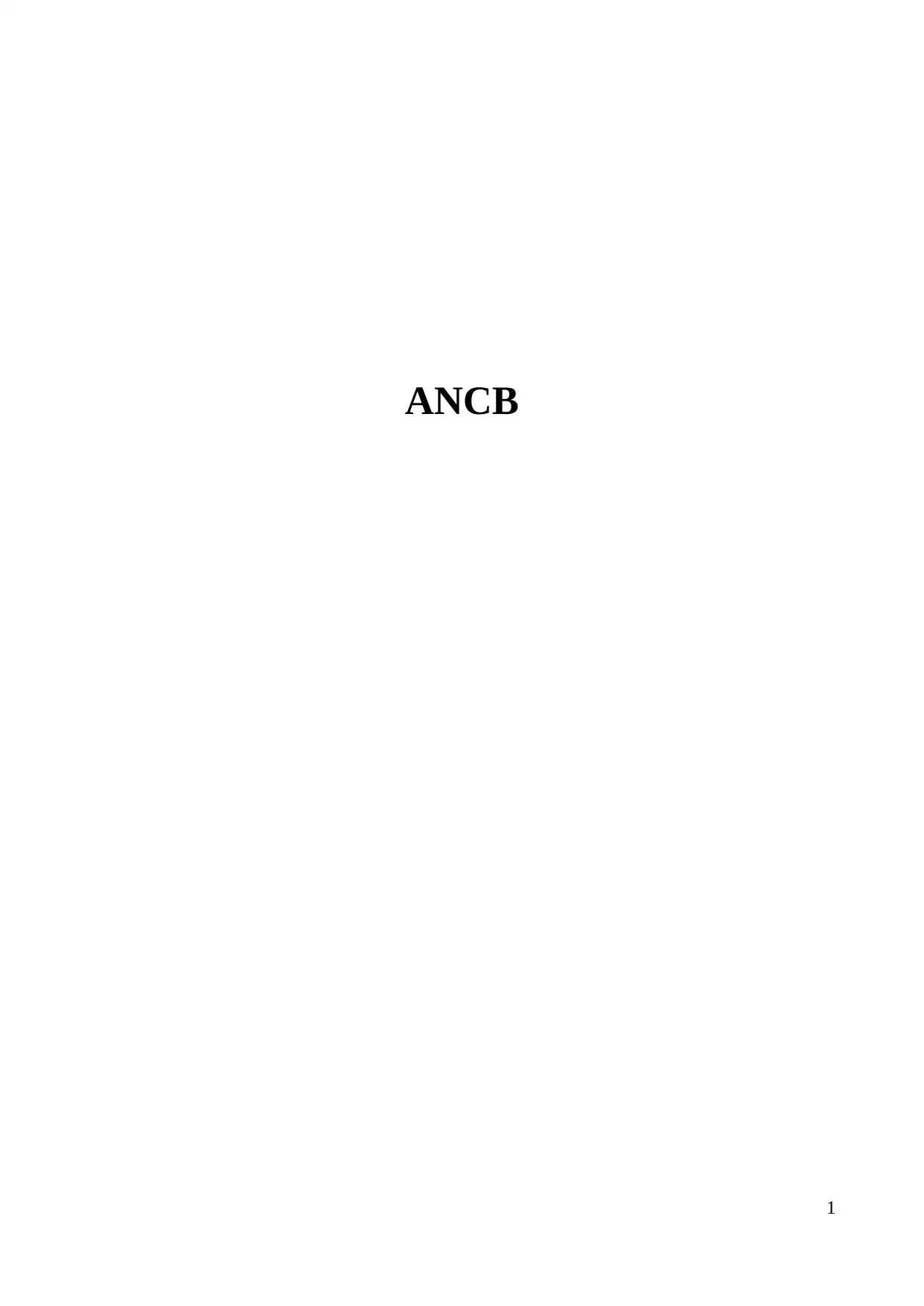
ANCB
1
1
Paraphrase This Document
Need a fresh take? Get an instant paraphrase of this document with our AI Paraphraser
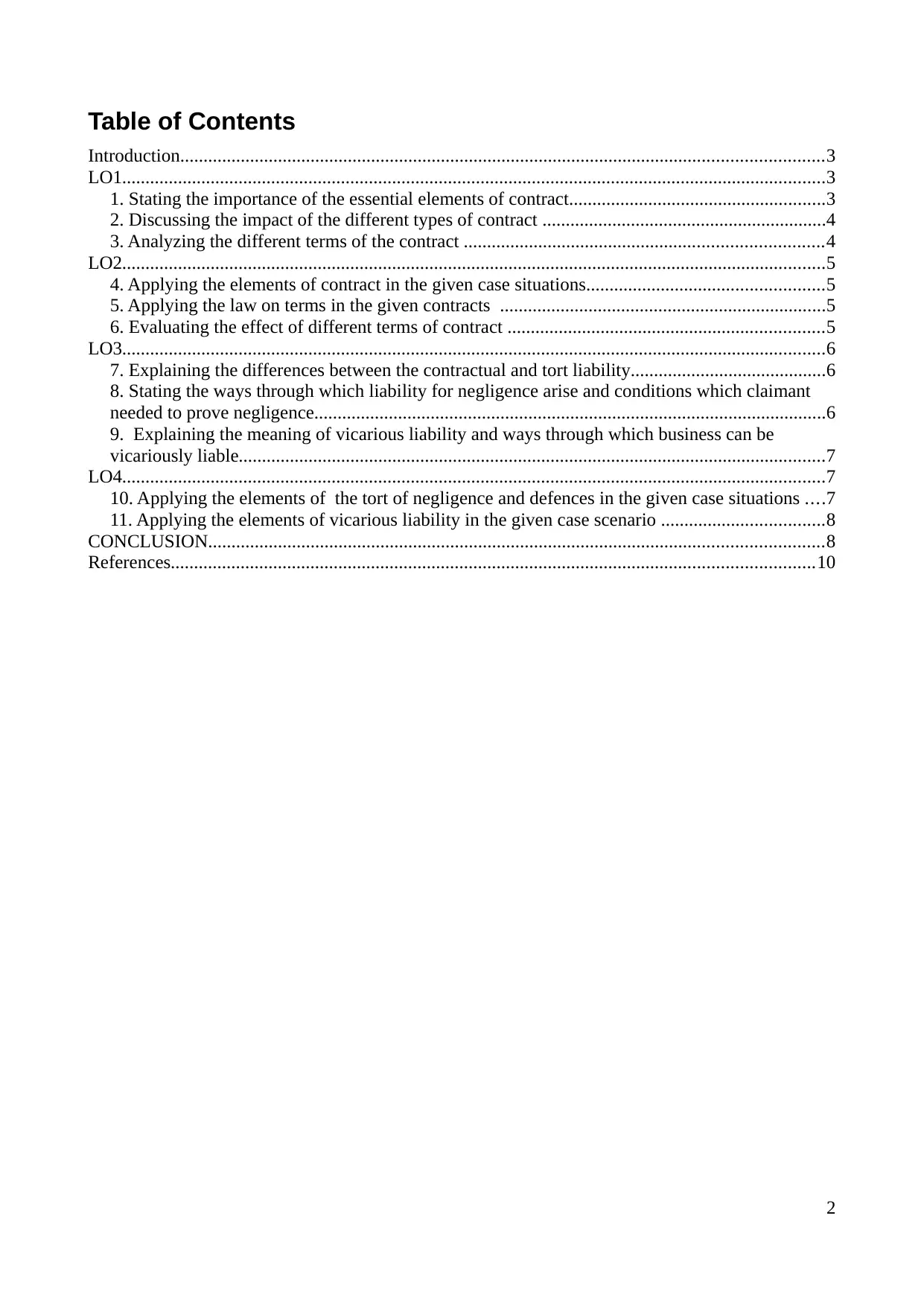
Table of Contents
Introduction..........................................................................................................................................3
LO1.......................................................................................................................................................3
1. Stating the importance of the essential elements of contract.......................................................3
2. Discussing the impact of the different types of contract .............................................................4
3. Analyzing the different terms of the contract .............................................................................4
LO2.......................................................................................................................................................5
4. Applying the elements of contract in the given case situations...................................................5
5. Applying the law on terms in the given contracts ......................................................................5
6. Evaluating the effect of different terms of contract ....................................................................5
LO3.......................................................................................................................................................6
7. Explaining the differences between the contractual and tort liability..........................................6
8. Stating the ways through which liability for negligence arise and conditions which claimant
needed to prove negligence..............................................................................................................6
9. Explaining the meaning of vicarious liability and ways through which business can be
vicariously liable..............................................................................................................................7
LO4.......................................................................................................................................................7
10. Applying the elements of the tort of negligence and defences in the given case situations ....7
11. Applying the elements of vicarious liability in the given case scenario ...................................8
CONCLUSION....................................................................................................................................8
References..........................................................................................................................................10
2
Introduction..........................................................................................................................................3
LO1.......................................................................................................................................................3
1. Stating the importance of the essential elements of contract.......................................................3
2. Discussing the impact of the different types of contract .............................................................4
3. Analyzing the different terms of the contract .............................................................................4
LO2.......................................................................................................................................................5
4. Applying the elements of contract in the given case situations...................................................5
5. Applying the law on terms in the given contracts ......................................................................5
6. Evaluating the effect of different terms of contract ....................................................................5
LO3.......................................................................................................................................................6
7. Explaining the differences between the contractual and tort liability..........................................6
8. Stating the ways through which liability for negligence arise and conditions which claimant
needed to prove negligence..............................................................................................................6
9. Explaining the meaning of vicarious liability and ways through which business can be
vicariously liable..............................................................................................................................7
LO4.......................................................................................................................................................7
10. Applying the elements of the tort of negligence and defences in the given case situations ....7
11. Applying the elements of vicarious liability in the given case scenario ...................................8
CONCLUSION....................................................................................................................................8
References..........................................................................................................................................10
2
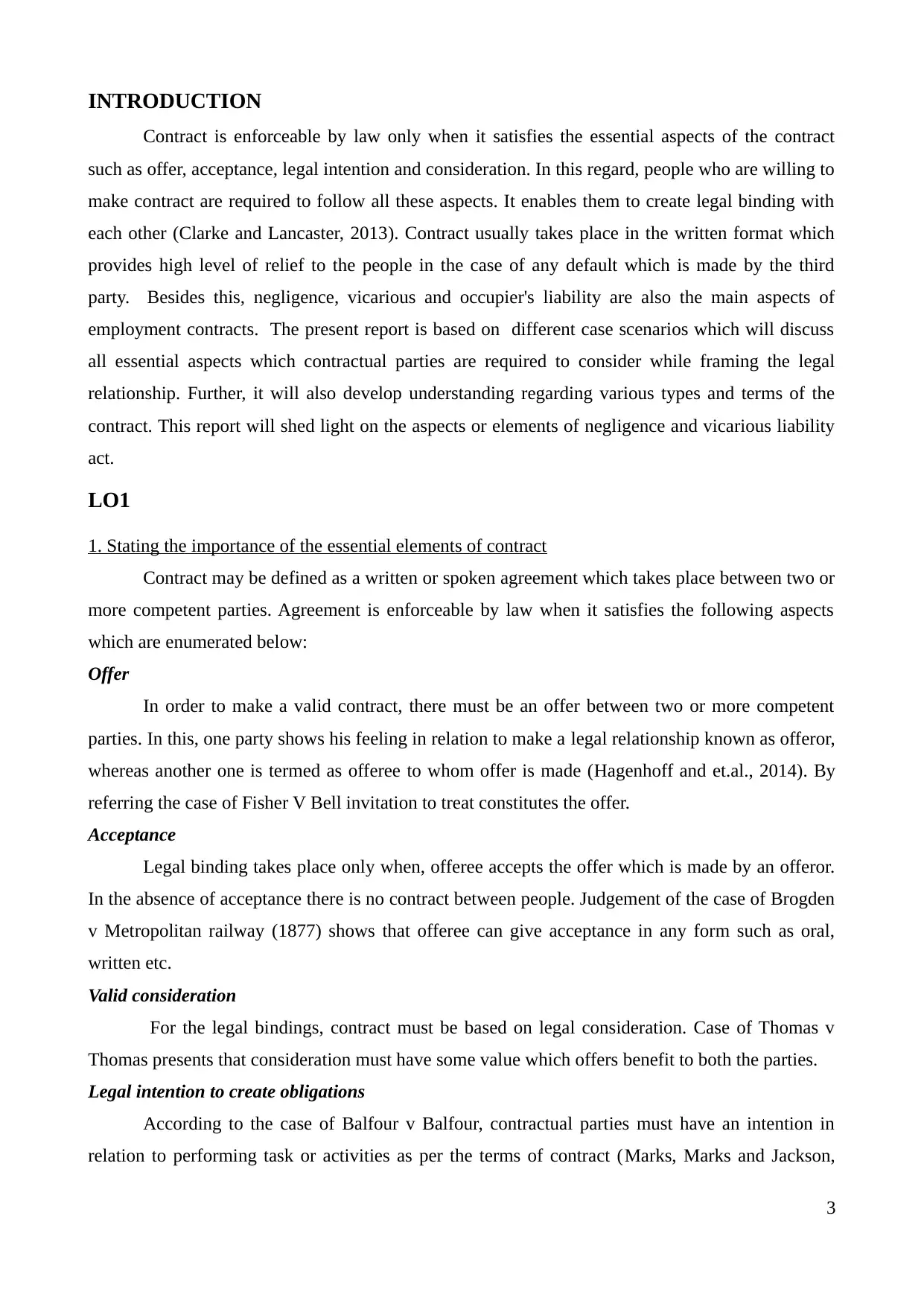
INTRODUCTION
Contract is enforceable by law only when it satisfies the essential aspects of the contract
such as offer, acceptance, legal intention and consideration. In this regard, people who are willing to
make contract are required to follow all these aspects. It enables them to create legal binding with
each other (Clarke and Lancaster, 2013). Contract usually takes place in the written format which
provides high level of relief to the people in the case of any default which is made by the third
party. Besides this, negligence, vicarious and occupier's liability are also the main aspects of
employment contracts. The present report is based on different case scenarios which will discuss
all essential aspects which contractual parties are required to consider while framing the legal
relationship. Further, it will also develop understanding regarding various types and terms of the
contract. This report will shed light on the aspects or elements of negligence and vicarious liability
act.
LO1
1. Stating the importance of the essential elements of contract
Contract may be defined as a written or spoken agreement which takes place between two or
more competent parties. Agreement is enforceable by law when it satisfies the following aspects
which are enumerated below:
Offer
In order to make a valid contract, there must be an offer between two or more competent
parties. In this, one party shows his feeling in relation to make a legal relationship known as offeror,
whereas another one is termed as offeree to whom offer is made (Hagenhoff and et.al., 2014). By
referring the case of Fisher V Bell invitation to treat constitutes the offer.
Acceptance
Legal binding takes place only when, offeree accepts the offer which is made by an offeror.
In the absence of acceptance there is no contract between people. Judgement of the case of Brogden
v Metropolitan railway (1877) shows that offeree can give acceptance in any form such as oral,
written etc.
Valid consideration
For the legal bindings, contract must be based on legal consideration. Case of Thomas v
Thomas presents that consideration must have some value which offers benefit to both the parties.
Legal intention to create obligations
According to the case of Balfour v Balfour, contractual parties must have an intention in
relation to performing task or activities as per the terms of contract (Marks, Marks and Jackson,
3
Contract is enforceable by law only when it satisfies the essential aspects of the contract
such as offer, acceptance, legal intention and consideration. In this regard, people who are willing to
make contract are required to follow all these aspects. It enables them to create legal binding with
each other (Clarke and Lancaster, 2013). Contract usually takes place in the written format which
provides high level of relief to the people in the case of any default which is made by the third
party. Besides this, negligence, vicarious and occupier's liability are also the main aspects of
employment contracts. The present report is based on different case scenarios which will discuss
all essential aspects which contractual parties are required to consider while framing the legal
relationship. Further, it will also develop understanding regarding various types and terms of the
contract. This report will shed light on the aspects or elements of negligence and vicarious liability
act.
LO1
1. Stating the importance of the essential elements of contract
Contract may be defined as a written or spoken agreement which takes place between two or
more competent parties. Agreement is enforceable by law when it satisfies the following aspects
which are enumerated below:
Offer
In order to make a valid contract, there must be an offer between two or more competent
parties. In this, one party shows his feeling in relation to make a legal relationship known as offeror,
whereas another one is termed as offeree to whom offer is made (Hagenhoff and et.al., 2014). By
referring the case of Fisher V Bell invitation to treat constitutes the offer.
Acceptance
Legal binding takes place only when, offeree accepts the offer which is made by an offeror.
In the absence of acceptance there is no contract between people. Judgement of the case of Brogden
v Metropolitan railway (1877) shows that offeree can give acceptance in any form such as oral,
written etc.
Valid consideration
For the legal bindings, contract must be based on legal consideration. Case of Thomas v
Thomas presents that consideration must have some value which offers benefit to both the parties.
Legal intention to create obligations
According to the case of Balfour v Balfour, contractual parties must have an intention in
relation to performing task or activities as per the terms of contract (Marks, Marks and Jackson,
3
⊘ This is a preview!⊘
Do you want full access?
Subscribe today to unlock all pages.

Trusted by 1+ million students worldwide
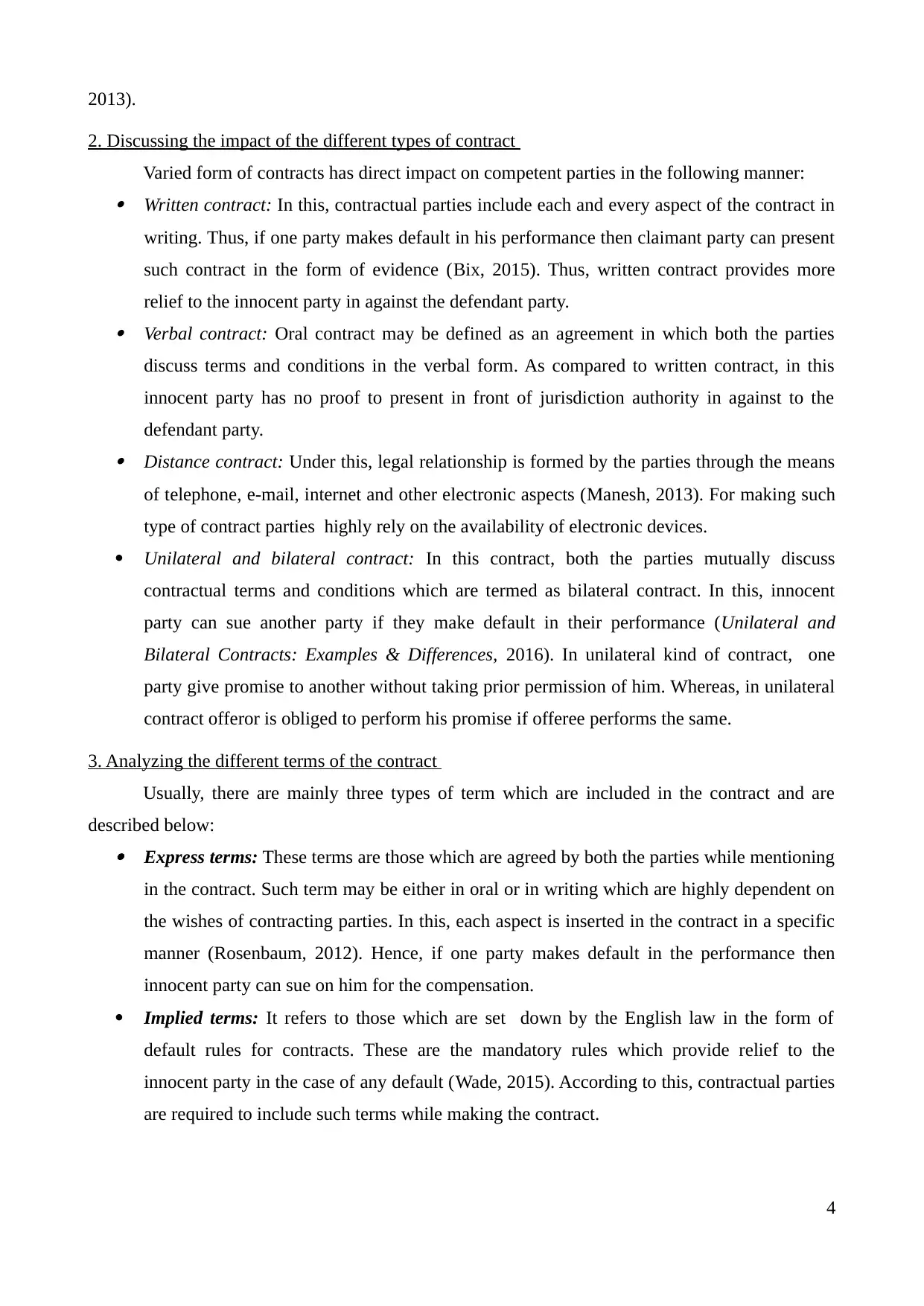
2013).
2. Discussing the impact of the different types of contract
Varied form of contracts has direct impact on competent parties in the following manner: Written contract: In this, contractual parties include each and every aspect of the contract in
writing. Thus, if one party makes default in his performance then claimant party can present
such contract in the form of evidence (Bix, 2015). Thus, written contract provides more
relief to the innocent party in against the defendant party. Verbal contract: Oral contract may be defined as an agreement in which both the parties
discuss terms and conditions in the verbal form. As compared to written contract, in this
innocent party has no proof to present in front of jurisdiction authority in against to the
defendant party. Distance contract: Under this, legal relationship is formed by the parties through the means
of telephone, e-mail, internet and other electronic aspects (Manesh, 2013). For making such
type of contract parties highly rely on the availability of electronic devices.
Unilateral and bilateral contract: In this contract, both the parties mutually discuss
contractual terms and conditions which are termed as bilateral contract. In this, innocent
party can sue another party if they make default in their performance (Unilateral and
Bilateral Contracts: Examples & Differences, 2016). In unilateral kind of contract, one
party give promise to another without taking prior permission of him. Whereas, in unilateral
contract offeror is obliged to perform his promise if offeree performs the same.
3. Analyzing the different terms of the contract
Usually, there are mainly three types of term which are included in the contract and are
described below: Express terms: These terms are those which are agreed by both the parties while mentioning
in the contract. Such term may be either in oral or in writing which are highly dependent on
the wishes of contracting parties. In this, each aspect is inserted in the contract in a specific
manner (Rosenbaum, 2012). Hence, if one party makes default in the performance then
innocent party can sue on him for the compensation.
Implied terms: It refers to those which are set down by the English law in the form of
default rules for contracts. These are the mandatory rules which provide relief to the
innocent party in the case of any default (Wade, 2015). According to this, contractual parties
are required to include such terms while making the contract.
4
2. Discussing the impact of the different types of contract
Varied form of contracts has direct impact on competent parties in the following manner: Written contract: In this, contractual parties include each and every aspect of the contract in
writing. Thus, if one party makes default in his performance then claimant party can present
such contract in the form of evidence (Bix, 2015). Thus, written contract provides more
relief to the innocent party in against the defendant party. Verbal contract: Oral contract may be defined as an agreement in which both the parties
discuss terms and conditions in the verbal form. As compared to written contract, in this
innocent party has no proof to present in front of jurisdiction authority in against to the
defendant party. Distance contract: Under this, legal relationship is formed by the parties through the means
of telephone, e-mail, internet and other electronic aspects (Manesh, 2013). For making such
type of contract parties highly rely on the availability of electronic devices.
Unilateral and bilateral contract: In this contract, both the parties mutually discuss
contractual terms and conditions which are termed as bilateral contract. In this, innocent
party can sue another party if they make default in their performance (Unilateral and
Bilateral Contracts: Examples & Differences, 2016). In unilateral kind of contract, one
party give promise to another without taking prior permission of him. Whereas, in unilateral
contract offeror is obliged to perform his promise if offeree performs the same.
3. Analyzing the different terms of the contract
Usually, there are mainly three types of term which are included in the contract and are
described below: Express terms: These terms are those which are agreed by both the parties while mentioning
in the contract. Such term may be either in oral or in writing which are highly dependent on
the wishes of contracting parties. In this, each aspect is inserted in the contract in a specific
manner (Rosenbaum, 2012). Hence, if one party makes default in the performance then
innocent party can sue on him for the compensation.
Implied terms: It refers to those which are set down by the English law in the form of
default rules for contracts. These are the mandatory rules which provide relief to the
innocent party in the case of any default (Wade, 2015). According to this, contractual parties
are required to include such terms while making the contract.
4
Paraphrase This Document
Need a fresh take? Get an instant paraphrase of this document with our AI Paraphraser
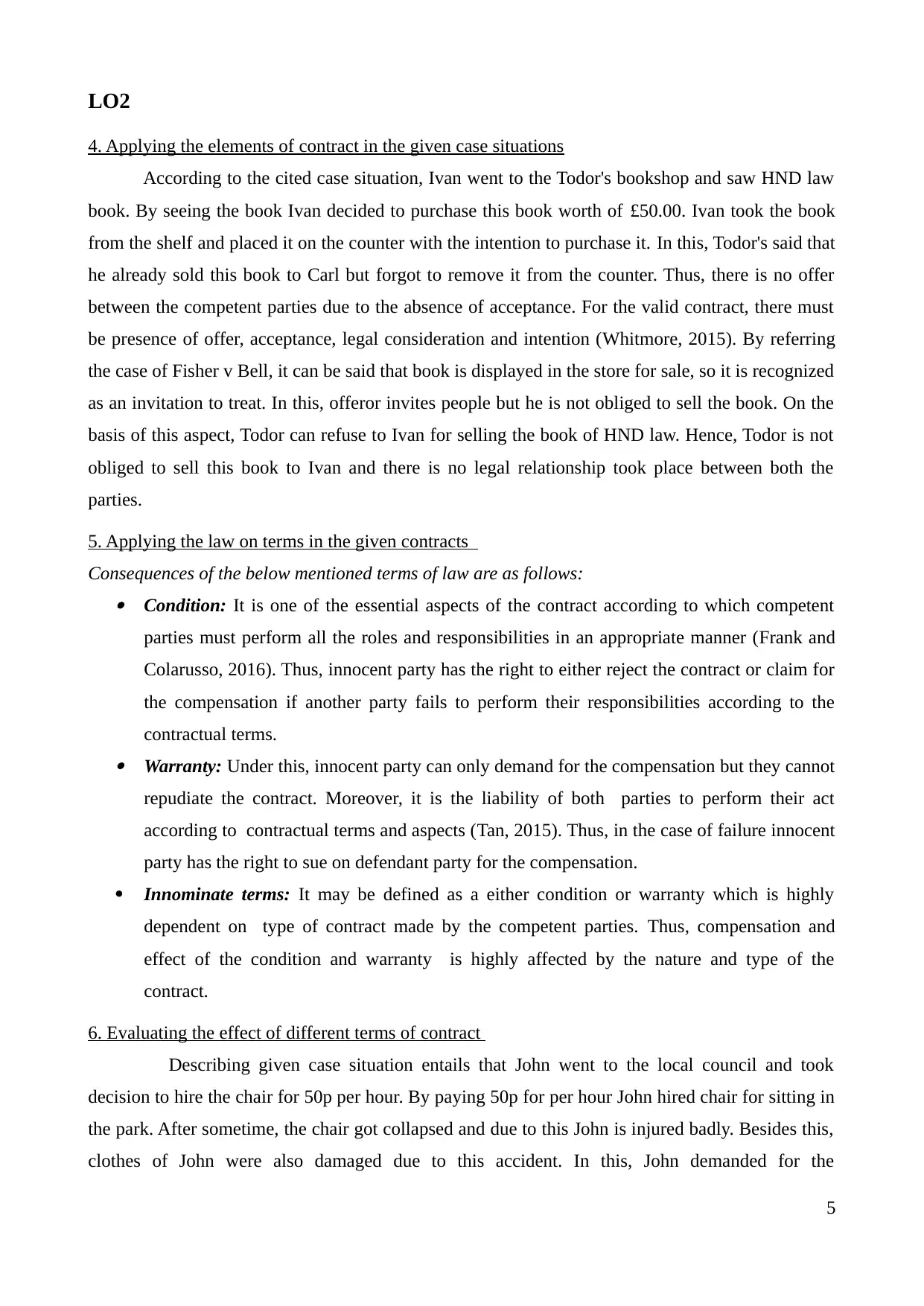
LO2
4. Applying the elements of contract in the given case situations
According to the cited case situation, Ivan went to the Todor's bookshop and saw HND law
book. By seeing the book Ivan decided to purchase this book worth of £50.00. Ivan took the book
from the shelf and placed it on the counter with the intention to purchase it. In this, Todor's said that
he already sold this book to Carl but forgot to remove it from the counter. Thus, there is no offer
between the competent parties due to the absence of acceptance. For the valid contract, there must
be presence of offer, acceptance, legal consideration and intention (Whitmore, 2015). By referring
the case of Fisher v Bell, it can be said that book is displayed in the store for sale, so it is recognized
as an invitation to treat. In this, offeror invites people but he is not obliged to sell the book. On the
basis of this aspect, Todor can refuse to Ivan for selling the book of HND law. Hence, Todor is not
obliged to sell this book to Ivan and there is no legal relationship took place between both the
parties.
5. Applying the law on terms in the given contracts
Consequences of the below mentioned terms of law are as follows: Condition: It is one of the essential aspects of the contract according to which competent
parties must perform all the roles and responsibilities in an appropriate manner (Frank and
Colarusso, 2016). Thus, innocent party has the right to either reject the contract or claim for
the compensation if another party fails to perform their responsibilities according to the
contractual terms. Warranty: Under this, innocent party can only demand for the compensation but they cannot
repudiate the contract. Moreover, it is the liability of both parties to perform their act
according to contractual terms and aspects (Tan, 2015). Thus, in the case of failure innocent
party has the right to sue on defendant party for the compensation.
Innominate terms: It may be defined as a either condition or warranty which is highly
dependent on type of contract made by the competent parties. Thus, compensation and
effect of the condition and warranty is highly affected by the nature and type of the
contract.
6. Evaluating the effect of different terms of contract
Describing given case situation entails that John went to the local council and took
decision to hire the chair for 50p per hour. By paying 50p for per hour John hired chair for sitting in
the park. After sometime, the chair got collapsed and due to this John is injured badly. Besides this,
clothes of John were also damaged due to this accident. In this, John demanded for the
5
4. Applying the elements of contract in the given case situations
According to the cited case situation, Ivan went to the Todor's bookshop and saw HND law
book. By seeing the book Ivan decided to purchase this book worth of £50.00. Ivan took the book
from the shelf and placed it on the counter with the intention to purchase it. In this, Todor's said that
he already sold this book to Carl but forgot to remove it from the counter. Thus, there is no offer
between the competent parties due to the absence of acceptance. For the valid contract, there must
be presence of offer, acceptance, legal consideration and intention (Whitmore, 2015). By referring
the case of Fisher v Bell, it can be said that book is displayed in the store for sale, so it is recognized
as an invitation to treat. In this, offeror invites people but he is not obliged to sell the book. On the
basis of this aspect, Todor can refuse to Ivan for selling the book of HND law. Hence, Todor is not
obliged to sell this book to Ivan and there is no legal relationship took place between both the
parties.
5. Applying the law on terms in the given contracts
Consequences of the below mentioned terms of law are as follows: Condition: It is one of the essential aspects of the contract according to which competent
parties must perform all the roles and responsibilities in an appropriate manner (Frank and
Colarusso, 2016). Thus, innocent party has the right to either reject the contract or claim for
the compensation if another party fails to perform their responsibilities according to the
contractual terms. Warranty: Under this, innocent party can only demand for the compensation but they cannot
repudiate the contract. Moreover, it is the liability of both parties to perform their act
according to contractual terms and aspects (Tan, 2015). Thus, in the case of failure innocent
party has the right to sue on defendant party for the compensation.
Innominate terms: It may be defined as a either condition or warranty which is highly
dependent on type of contract made by the competent parties. Thus, compensation and
effect of the condition and warranty is highly affected by the nature and type of the
contract.
6. Evaluating the effect of different terms of contract
Describing given case situation entails that John went to the local council and took
decision to hire the chair for 50p per hour. By paying 50p for per hour John hired chair for sitting in
the park. After sometime, the chair got collapsed and due to this John is injured badly. Besides this,
clothes of John were also damaged due to this accident. In this, John demanded for the
5
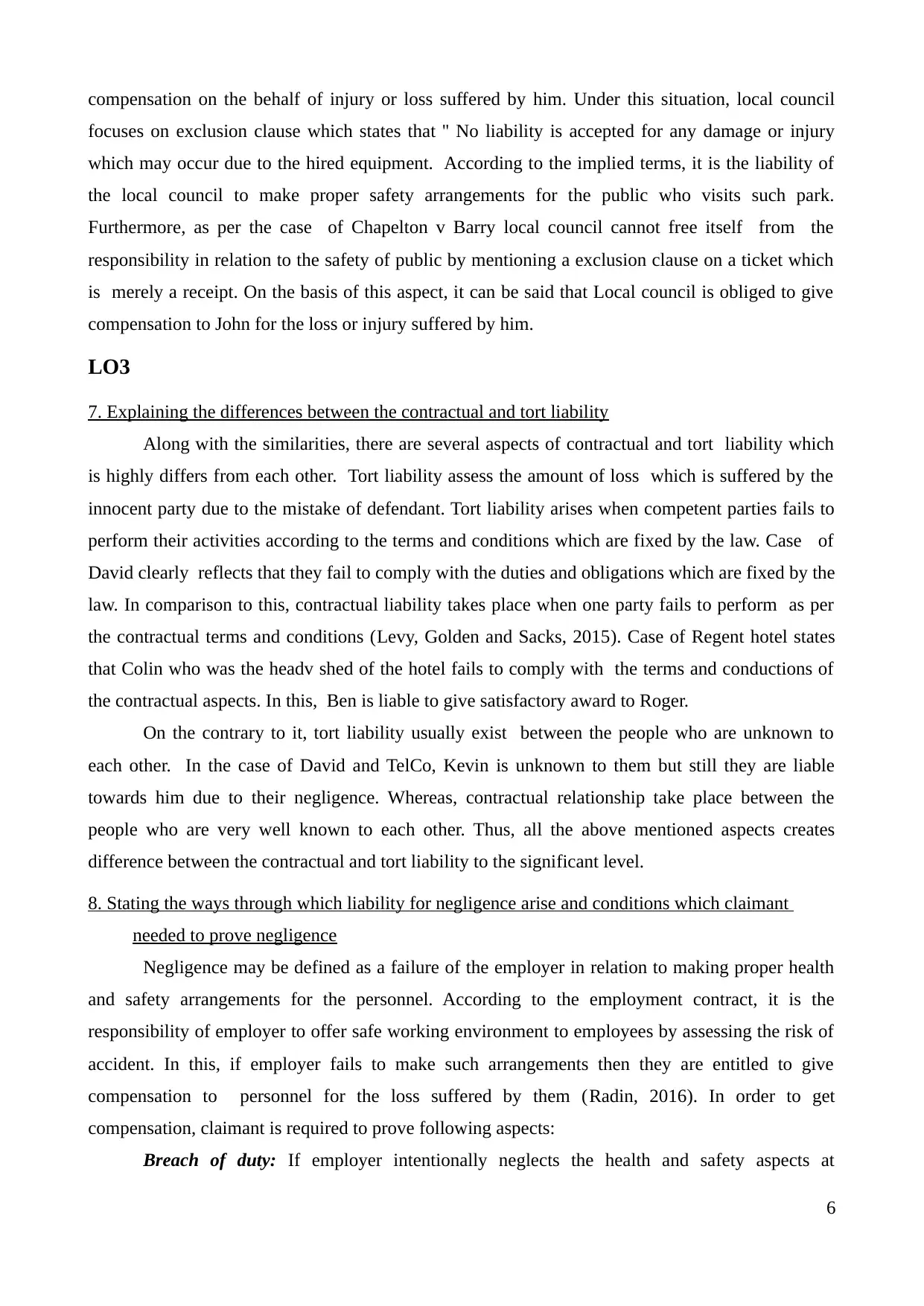
compensation on the behalf of injury or loss suffered by him. Under this situation, local council
focuses on exclusion clause which states that '' No liability is accepted for any damage or injury
which may occur due to the hired equipment. According to the implied terms, it is the liability of
the local council to make proper safety arrangements for the public who visits such park.
Furthermore, as per the case of Chapelton v Barry local council cannot free itself from the
responsibility in relation to the safety of public by mentioning a exclusion clause on a ticket which
is merely a receipt. On the basis of this aspect, it can be said that Local council is obliged to give
compensation to John for the loss or injury suffered by him.
LO3
7. Explaining the differences between the contractual and tort liability
Along with the similarities, there are several aspects of contractual and tort liability which
is highly differs from each other. Tort liability assess the amount of loss which is suffered by the
innocent party due to the mistake of defendant. Tort liability arises when competent parties fails to
perform their activities according to the terms and conditions which are fixed by the law. Case of
David clearly reflects that they fail to comply with the duties and obligations which are fixed by the
law. In comparison to this, contractual liability takes place when one party fails to perform as per
the contractual terms and conditions (Levy, Golden and Sacks, 2015). Case of Regent hotel states
that Colin who was the headv shed of the hotel fails to comply with the terms and conductions of
the contractual aspects. In this, Ben is liable to give satisfactory award to Roger.
On the contrary to it, tort liability usually exist between the people who are unknown to
each other. In the case of David and TelCo, Kevin is unknown to them but still they are liable
towards him due to their negligence. Whereas, contractual relationship take place between the
people who are very well known to each other. Thus, all the above mentioned aspects creates
difference between the contractual and tort liability to the significant level.
8. Stating the ways through which liability for negligence arise and conditions which claimant
needed to prove negligence
Negligence may be defined as a failure of the employer in relation to making proper health
and safety arrangements for the personnel. According to the employment contract, it is the
responsibility of employer to offer safe working environment to employees by assessing the risk of
accident. In this, if employer fails to make such arrangements then they are entitled to give
compensation to personnel for the loss suffered by them (Radin, 2016). In order to get
compensation, claimant is required to prove following aspects:
Breach of duty: If employer intentionally neglects the health and safety aspects at
6
focuses on exclusion clause which states that '' No liability is accepted for any damage or injury
which may occur due to the hired equipment. According to the implied terms, it is the liability of
the local council to make proper safety arrangements for the public who visits such park.
Furthermore, as per the case of Chapelton v Barry local council cannot free itself from the
responsibility in relation to the safety of public by mentioning a exclusion clause on a ticket which
is merely a receipt. On the basis of this aspect, it can be said that Local council is obliged to give
compensation to John for the loss or injury suffered by him.
LO3
7. Explaining the differences between the contractual and tort liability
Along with the similarities, there are several aspects of contractual and tort liability which
is highly differs from each other. Tort liability assess the amount of loss which is suffered by the
innocent party due to the mistake of defendant. Tort liability arises when competent parties fails to
perform their activities according to the terms and conditions which are fixed by the law. Case of
David clearly reflects that they fail to comply with the duties and obligations which are fixed by the
law. In comparison to this, contractual liability takes place when one party fails to perform as per
the contractual terms and conditions (Levy, Golden and Sacks, 2015). Case of Regent hotel states
that Colin who was the headv shed of the hotel fails to comply with the terms and conductions of
the contractual aspects. In this, Ben is liable to give satisfactory award to Roger.
On the contrary to it, tort liability usually exist between the people who are unknown to
each other. In the case of David and TelCo, Kevin is unknown to them but still they are liable
towards him due to their negligence. Whereas, contractual relationship take place between the
people who are very well known to each other. Thus, all the above mentioned aspects creates
difference between the contractual and tort liability to the significant level.
8. Stating the ways through which liability for negligence arise and conditions which claimant
needed to prove negligence
Negligence may be defined as a failure of the employer in relation to making proper health
and safety arrangements for the personnel. According to the employment contract, it is the
responsibility of employer to offer safe working environment to employees by assessing the risk of
accident. In this, if employer fails to make such arrangements then they are entitled to give
compensation to personnel for the loss suffered by them (Radin, 2016). In order to get
compensation, claimant is required to prove following aspects:
Breach of duty: If employer intentionally neglects the health and safety aspects at
6
⊘ This is a preview!⊘
Do you want full access?
Subscribe today to unlock all pages.

Trusted by 1+ million students worldwide
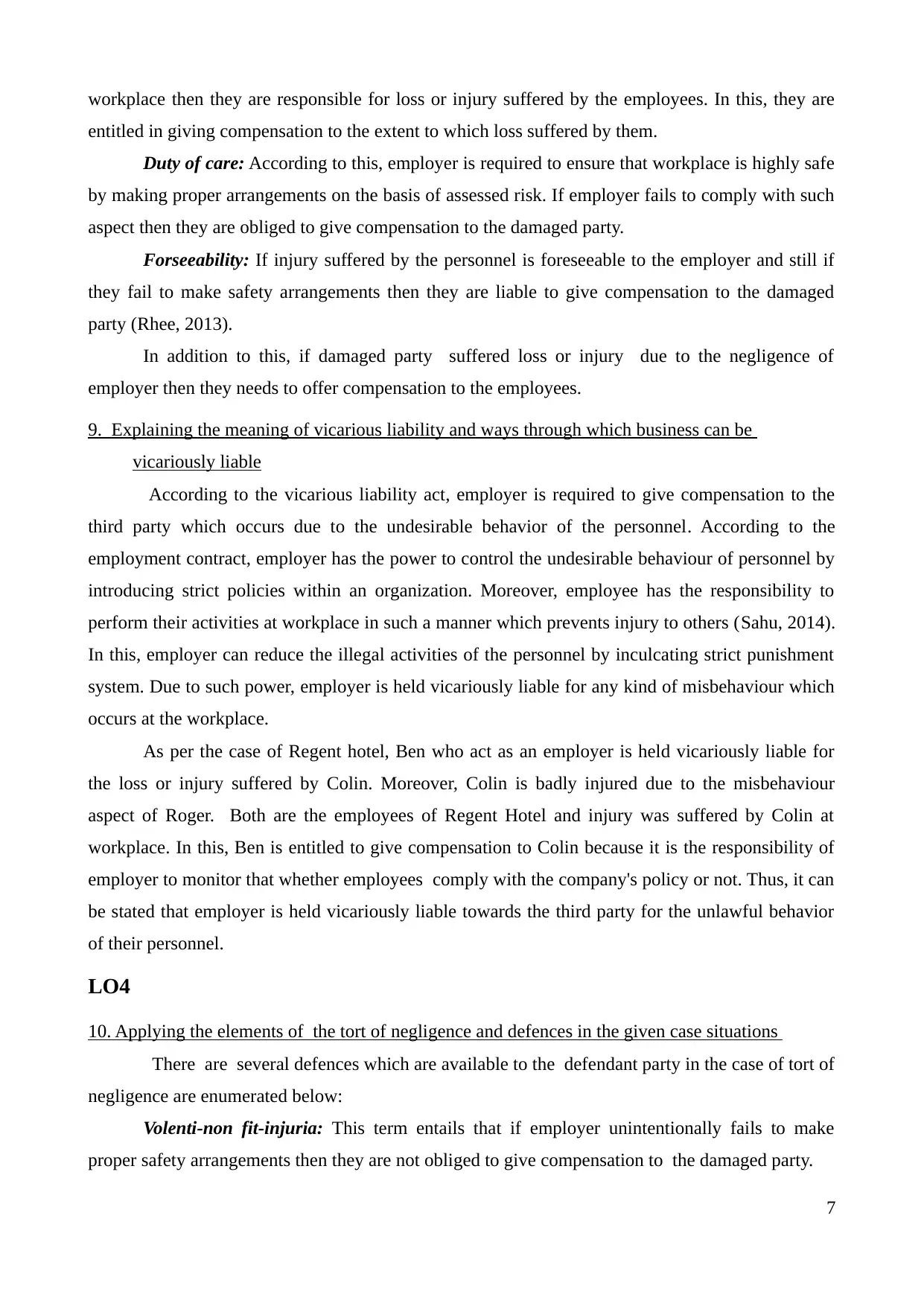
workplace then they are responsible for loss or injury suffered by the employees. In this, they are
entitled in giving compensation to the extent to which loss suffered by them.
Duty of care: According to this, employer is required to ensure that workplace is highly safe
by making proper arrangements on the basis of assessed risk. If employer fails to comply with such
aspect then they are obliged to give compensation to the damaged party.
Forseeability: If injury suffered by the personnel is foreseeable to the employer and still if
they fail to make safety arrangements then they are liable to give compensation to the damaged
party (Rhee, 2013).
In addition to this, if damaged party suffered loss or injury due to the negligence of
employer then they needs to offer compensation to the employees.
9. Explaining the meaning of vicarious liability and ways through which business can be
vicariously liable
According to the vicarious liability act, employer is required to give compensation to the
third party which occurs due to the undesirable behavior of the personnel. According to the
employment contract, employer has the power to control the undesirable behaviour of personnel by
introducing strict policies within an organization. Moreover, employee has the responsibility to
perform their activities at workplace in such a manner which prevents injury to others (Sahu, 2014).
In this, employer can reduce the illegal activities of the personnel by inculcating strict punishment
system. Due to such power, employer is held vicariously liable for any kind of misbehaviour which
occurs at the workplace.
As per the case of Regent hotel, Ben who act as an employer is held vicariously liable for
the loss or injury suffered by Colin. Moreover, Colin is badly injured due to the misbehaviour
aspect of Roger. Both are the employees of Regent Hotel and injury was suffered by Colin at
workplace. In this, Ben is entitled to give compensation to Colin because it is the responsibility of
employer to monitor that whether employees comply with the company's policy or not. Thus, it can
be stated that employer is held vicariously liable towards the third party for the unlawful behavior
of their personnel.
LO4
10. Applying the elements of the tort of negligence and defences in the given case situations
There are several defences which are available to the defendant party in the case of tort of
negligence are enumerated below:
Volenti-non fit-injuria: This term entails that if employer unintentionally fails to make
proper safety arrangements then they are not obliged to give compensation to the damaged party.
7
entitled in giving compensation to the extent to which loss suffered by them.
Duty of care: According to this, employer is required to ensure that workplace is highly safe
by making proper arrangements on the basis of assessed risk. If employer fails to comply with such
aspect then they are obliged to give compensation to the damaged party.
Forseeability: If injury suffered by the personnel is foreseeable to the employer and still if
they fail to make safety arrangements then they are liable to give compensation to the damaged
party (Rhee, 2013).
In addition to this, if damaged party suffered loss or injury due to the negligence of
employer then they needs to offer compensation to the employees.
9. Explaining the meaning of vicarious liability and ways through which business can be
vicariously liable
According to the vicarious liability act, employer is required to give compensation to the
third party which occurs due to the undesirable behavior of the personnel. According to the
employment contract, employer has the power to control the undesirable behaviour of personnel by
introducing strict policies within an organization. Moreover, employee has the responsibility to
perform their activities at workplace in such a manner which prevents injury to others (Sahu, 2014).
In this, employer can reduce the illegal activities of the personnel by inculcating strict punishment
system. Due to such power, employer is held vicariously liable for any kind of misbehaviour which
occurs at the workplace.
As per the case of Regent hotel, Ben who act as an employer is held vicariously liable for
the loss or injury suffered by Colin. Moreover, Colin is badly injured due to the misbehaviour
aspect of Roger. Both are the employees of Regent Hotel and injury was suffered by Colin at
workplace. In this, Ben is entitled to give compensation to Colin because it is the responsibility of
employer to monitor that whether employees comply with the company's policy or not. Thus, it can
be stated that employer is held vicariously liable towards the third party for the unlawful behavior
of their personnel.
LO4
10. Applying the elements of the tort of negligence and defences in the given case situations
There are several defences which are available to the defendant party in the case of tort of
negligence are enumerated below:
Volenti-non fit-injuria: This term entails that if employer unintentionally fails to make
proper safety arrangements then they are not obliged to give compensation to the damaged party.
7
Paraphrase This Document
Need a fresh take? Get an instant paraphrase of this document with our AI Paraphraser
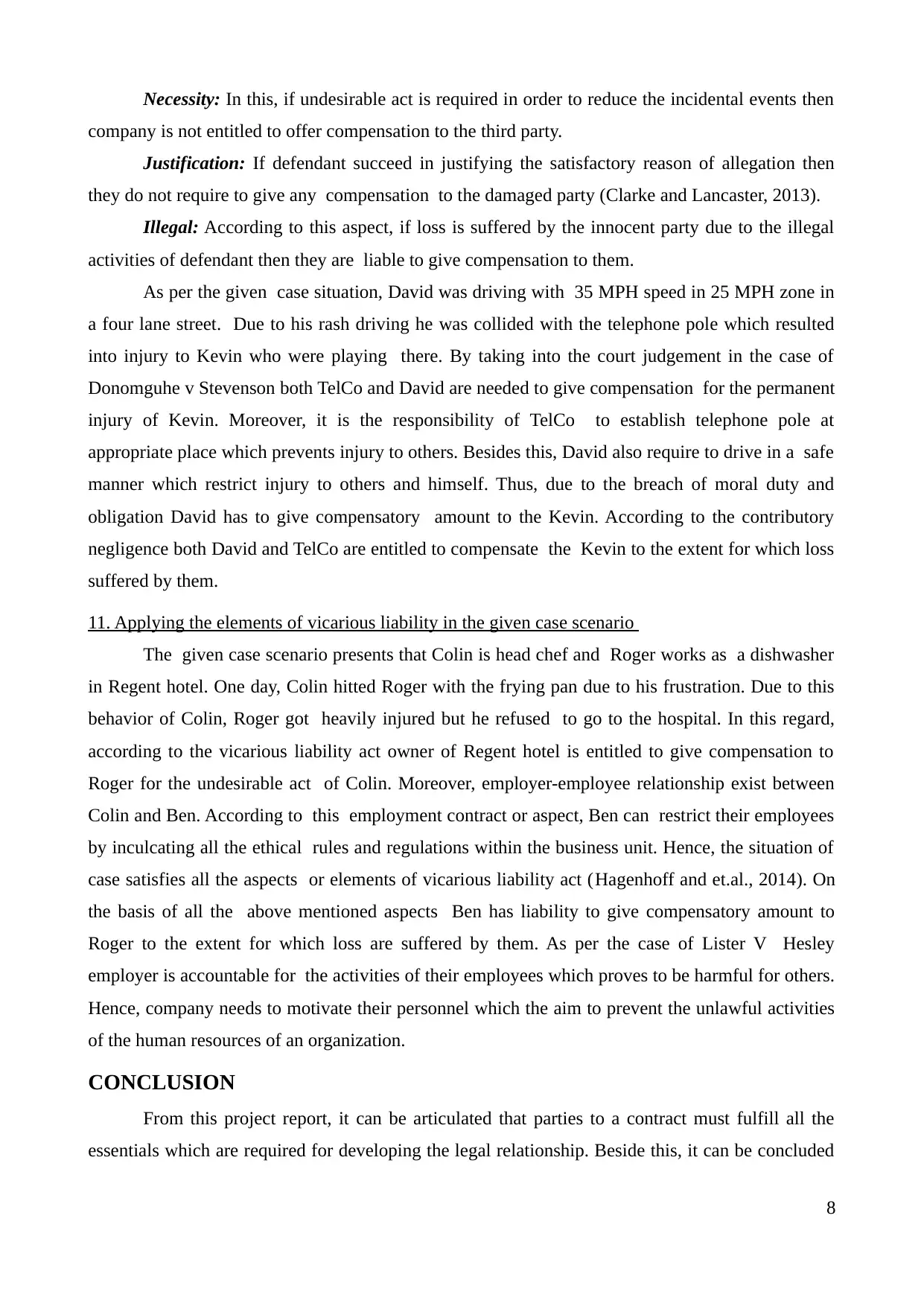
Necessity: In this, if undesirable act is required in order to reduce the incidental events then
company is not entitled to offer compensation to the third party.
Justification: If defendant succeed in justifying the satisfactory reason of allegation then
they do not require to give any compensation to the damaged party (Clarke and Lancaster, 2013).
Illegal: According to this aspect, if loss is suffered by the innocent party due to the illegal
activities of defendant then they are liable to give compensation to them.
As per the given case situation, David was driving with 35 MPH speed in 25 MPH zone in
a four lane street. Due to his rash driving he was collided with the telephone pole which resulted
into injury to Kevin who were playing there. By taking into the court judgement in the case of
Donomguhe v Stevenson both TelCo and David are needed to give compensation for the permanent
injury of Kevin. Moreover, it is the responsibility of TelCo to establish telephone pole at
appropriate place which prevents injury to others. Besides this, David also require to drive in a safe
manner which restrict injury to others and himself. Thus, due to the breach of moral duty and
obligation David has to give compensatory amount to the Kevin. According to the contributory
negligence both David and TelCo are entitled to compensate the Kevin to the extent for which loss
suffered by them.
11. Applying the elements of vicarious liability in the given case scenario
The given case scenario presents that Colin is head chef and Roger works as a dishwasher
in Regent hotel. One day, Colin hitted Roger with the frying pan due to his frustration. Due to this
behavior of Colin, Roger got heavily injured but he refused to go to the hospital. In this regard,
according to the vicarious liability act owner of Regent hotel is entitled to give compensation to
Roger for the undesirable act of Colin. Moreover, employer-employee relationship exist between
Colin and Ben. According to this employment contract or aspect, Ben can restrict their employees
by inculcating all the ethical rules and regulations within the business unit. Hence, the situation of
case satisfies all the aspects or elements of vicarious liability act (Hagenhoff and et.al., 2014). On
the basis of all the above mentioned aspects Ben has liability to give compensatory amount to
Roger to the extent for which loss are suffered by them. As per the case of Lister V Hesley
employer is accountable for the activities of their employees which proves to be harmful for others.
Hence, company needs to motivate their personnel which the aim to prevent the unlawful activities
of the human resources of an organization.
CONCLUSION
From this project report, it can be articulated that parties to a contract must fulfill all the
essentials which are required for developing the legal relationship. Beside this, it can be concluded
8
company is not entitled to offer compensation to the third party.
Justification: If defendant succeed in justifying the satisfactory reason of allegation then
they do not require to give any compensation to the damaged party (Clarke and Lancaster, 2013).
Illegal: According to this aspect, if loss is suffered by the innocent party due to the illegal
activities of defendant then they are liable to give compensation to them.
As per the given case situation, David was driving with 35 MPH speed in 25 MPH zone in
a four lane street. Due to his rash driving he was collided with the telephone pole which resulted
into injury to Kevin who were playing there. By taking into the court judgement in the case of
Donomguhe v Stevenson both TelCo and David are needed to give compensation for the permanent
injury of Kevin. Moreover, it is the responsibility of TelCo to establish telephone pole at
appropriate place which prevents injury to others. Besides this, David also require to drive in a safe
manner which restrict injury to others and himself. Thus, due to the breach of moral duty and
obligation David has to give compensatory amount to the Kevin. According to the contributory
negligence both David and TelCo are entitled to compensate the Kevin to the extent for which loss
suffered by them.
11. Applying the elements of vicarious liability in the given case scenario
The given case scenario presents that Colin is head chef and Roger works as a dishwasher
in Regent hotel. One day, Colin hitted Roger with the frying pan due to his frustration. Due to this
behavior of Colin, Roger got heavily injured but he refused to go to the hospital. In this regard,
according to the vicarious liability act owner of Regent hotel is entitled to give compensation to
Roger for the undesirable act of Colin. Moreover, employer-employee relationship exist between
Colin and Ben. According to this employment contract or aspect, Ben can restrict their employees
by inculcating all the ethical rules and regulations within the business unit. Hence, the situation of
case satisfies all the aspects or elements of vicarious liability act (Hagenhoff and et.al., 2014). On
the basis of all the above mentioned aspects Ben has liability to give compensatory amount to
Roger to the extent for which loss are suffered by them. As per the case of Lister V Hesley
employer is accountable for the activities of their employees which proves to be harmful for others.
Hence, company needs to motivate their personnel which the aim to prevent the unlawful activities
of the human resources of an organization.
CONCLUSION
From this project report, it can be articulated that parties to a contract must fulfill all the
essentials which are required for developing the legal relationship. Beside this, it can be concluded
8
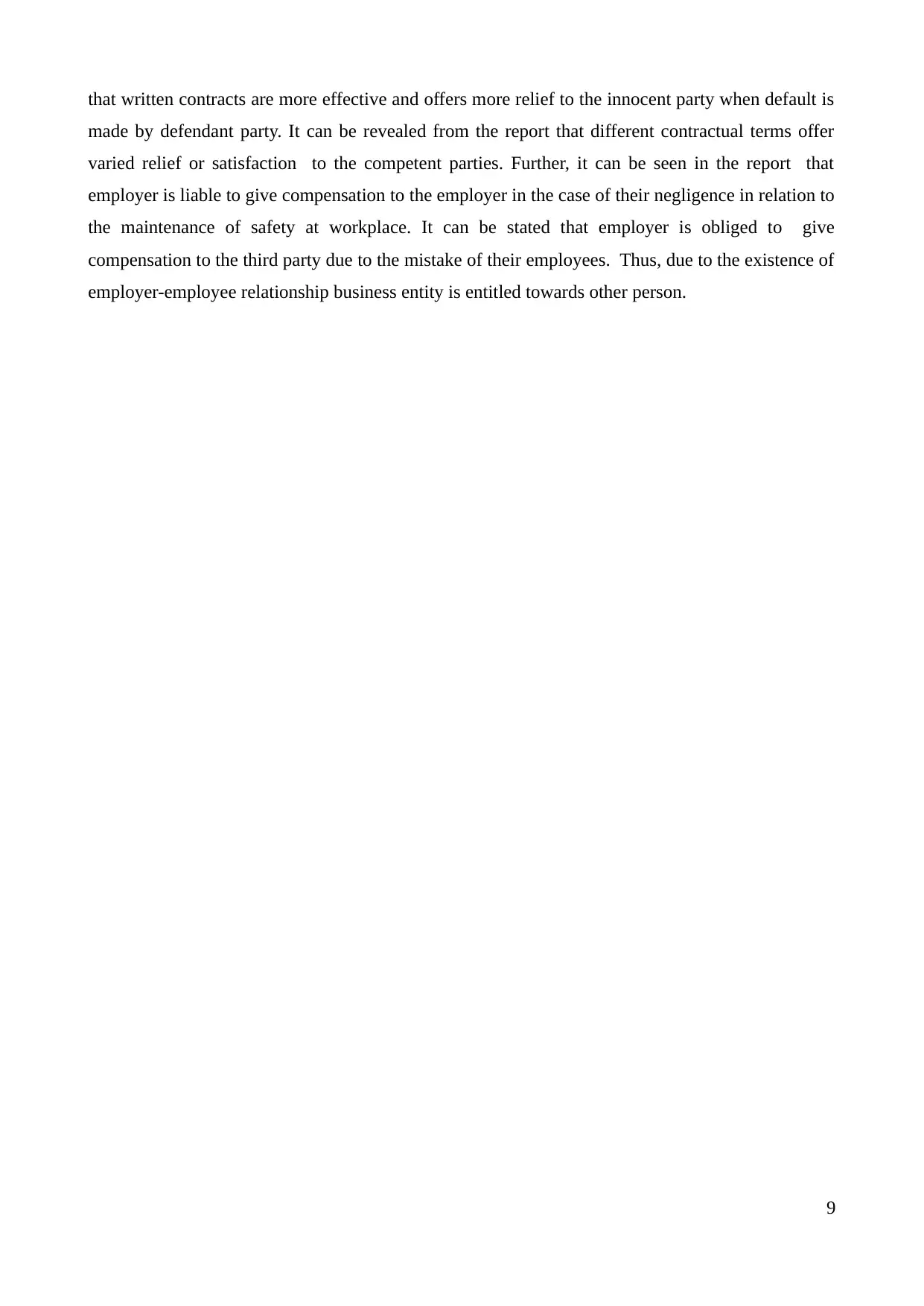
that written contracts are more effective and offers more relief to the innocent party when default is
made by defendant party. It can be revealed from the report that different contractual terms offer
varied relief or satisfaction to the competent parties. Further, it can be seen in the report that
employer is liable to give compensation to the employer in the case of their negligence in relation to
the maintenance of safety at workplace. It can be stated that employer is obliged to give
compensation to the third party due to the mistake of their employees. Thus, due to the existence of
employer-employee relationship business entity is entitled towards other person.
9
made by defendant party. It can be revealed from the report that different contractual terms offer
varied relief or satisfaction to the competent parties. Further, it can be seen in the report that
employer is liable to give compensation to the employer in the case of their negligence in relation to
the maintenance of safety at workplace. It can be stated that employer is obliged to give
compensation to the third party due to the mistake of their employees. Thus, due to the existence of
employer-employee relationship business entity is entitled towards other person.
9
⊘ This is a preview!⊘
Do you want full access?
Subscribe today to unlock all pages.

Trusted by 1+ million students worldwide
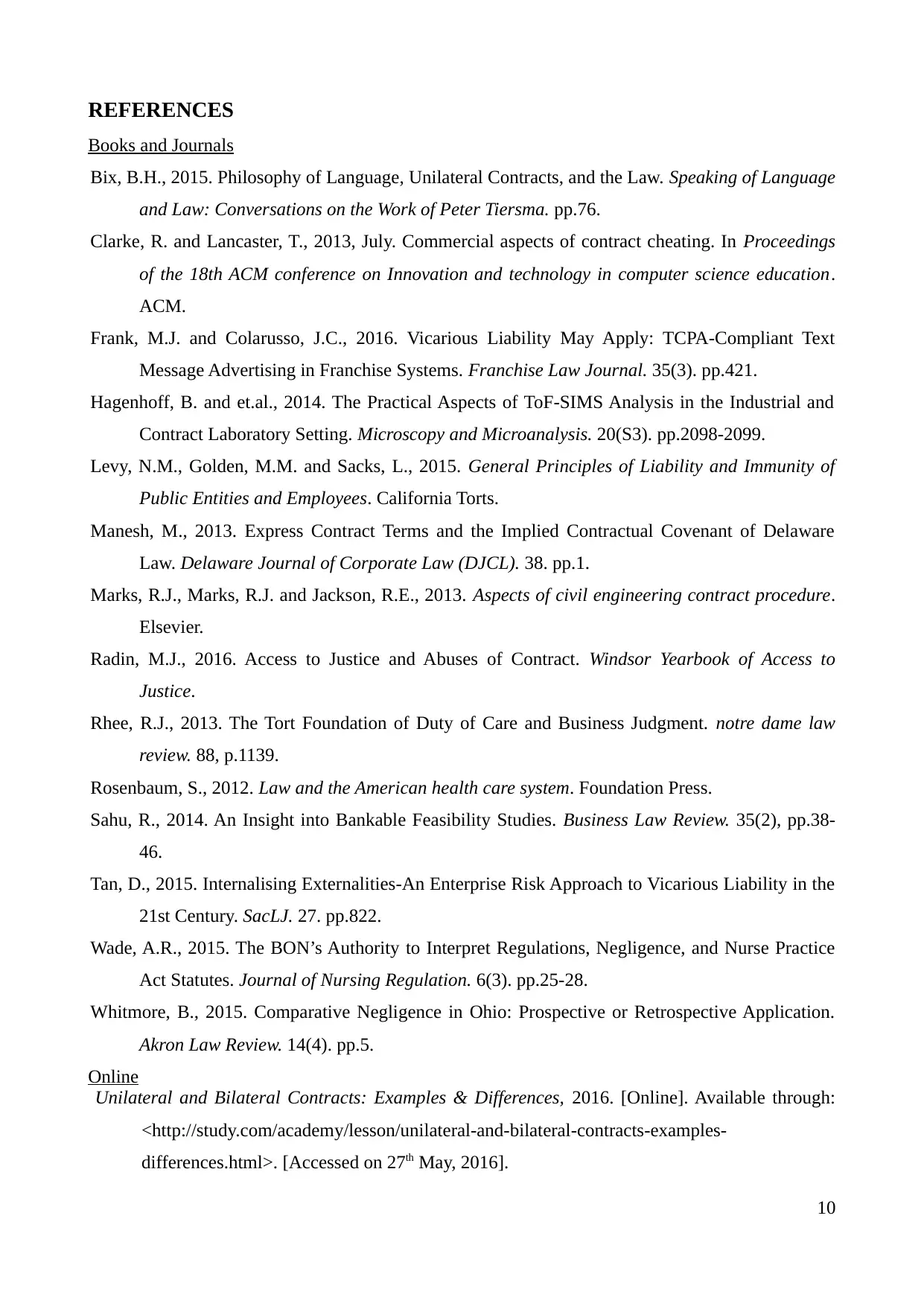
REFERENCES
Books and Journals
Bix, B.H., 2015. Philosophy of Language, Unilateral Contracts, and the Law. Speaking of Language
and Law: Conversations on the Work of Peter Tiersma. pp.76.
Clarke, R. and Lancaster, T., 2013, July. Commercial aspects of contract cheating. In Proceedings
of the 18th ACM conference on Innovation and technology in computer science education.
ACM.
Frank, M.J. and Colarusso, J.C., 2016. Vicarious Liability May Apply: TCPA-Compliant Text
Message Advertising in Franchise Systems. Franchise Law Journal. 35(3). pp.421.
Hagenhoff, B. and et.al., 2014. The Practical Aspects of ToF-SIMS Analysis in the Industrial and
Contract Laboratory Setting. Microscopy and Microanalysis. 20(S3). pp.2098-2099.
Levy, N.M., Golden, M.M. and Sacks, L., 2015. General Principles of Liability and Immunity of
Public Entities and Employees. California Torts.
Manesh, M., 2013. Express Contract Terms and the Implied Contractual Covenant of Delaware
Law. Delaware Journal of Corporate Law (DJCL). 38. pp.1.
Marks, R.J., Marks, R.J. and Jackson, R.E., 2013. Aspects of civil engineering contract procedure.
Elsevier.
Radin, M.J., 2016. Access to Justice and Abuses of Contract. Windsor Yearbook of Access to
Justice.
Rhee, R.J., 2013. The Tort Foundation of Duty of Care and Business Judgment. notre dame law
review. 88, p.1139.
Rosenbaum, S., 2012. Law and the American health care system. Foundation Press.
Sahu, R., 2014. An Insight into Bankable Feasibility Studies. Business Law Review. 35(2), pp.38-
46.
Tan, D., 2015. Internalising Externalities-An Enterprise Risk Approach to Vicarious Liability in the
21st Century. SacLJ. 27. pp.822.
Wade, A.R., 2015. The BON’s Authority to Interpret Regulations, Negligence, and Nurse Practice
Act Statutes. Journal of Nursing Regulation. 6(3). pp.25-28.
Whitmore, B., 2015. Comparative Negligence in Ohio: Prospective or Retrospective Application.
Akron Law Review. 14(4). pp.5.
Online
Unilateral and Bilateral Contracts: Examples & Differences, 2016. [Online]. Available through:
<http://study.com/academy/lesson/unilateral-and-bilateral-contracts-examples-
differences.html>. [Accessed on 27th May, 2016].
10
Books and Journals
Bix, B.H., 2015. Philosophy of Language, Unilateral Contracts, and the Law. Speaking of Language
and Law: Conversations on the Work of Peter Tiersma. pp.76.
Clarke, R. and Lancaster, T., 2013, July. Commercial aspects of contract cheating. In Proceedings
of the 18th ACM conference on Innovation and technology in computer science education.
ACM.
Frank, M.J. and Colarusso, J.C., 2016. Vicarious Liability May Apply: TCPA-Compliant Text
Message Advertising in Franchise Systems. Franchise Law Journal. 35(3). pp.421.
Hagenhoff, B. and et.al., 2014. The Practical Aspects of ToF-SIMS Analysis in the Industrial and
Contract Laboratory Setting. Microscopy and Microanalysis. 20(S3). pp.2098-2099.
Levy, N.M., Golden, M.M. and Sacks, L., 2015. General Principles of Liability and Immunity of
Public Entities and Employees. California Torts.
Manesh, M., 2013. Express Contract Terms and the Implied Contractual Covenant of Delaware
Law. Delaware Journal of Corporate Law (DJCL). 38. pp.1.
Marks, R.J., Marks, R.J. and Jackson, R.E., 2013. Aspects of civil engineering contract procedure.
Elsevier.
Radin, M.J., 2016. Access to Justice and Abuses of Contract. Windsor Yearbook of Access to
Justice.
Rhee, R.J., 2013. The Tort Foundation of Duty of Care and Business Judgment. notre dame law
review. 88, p.1139.
Rosenbaum, S., 2012. Law and the American health care system. Foundation Press.
Sahu, R., 2014. An Insight into Bankable Feasibility Studies. Business Law Review. 35(2), pp.38-
46.
Tan, D., 2015. Internalising Externalities-An Enterprise Risk Approach to Vicarious Liability in the
21st Century. SacLJ. 27. pp.822.
Wade, A.R., 2015. The BON’s Authority to Interpret Regulations, Negligence, and Nurse Practice
Act Statutes. Journal of Nursing Regulation. 6(3). pp.25-28.
Whitmore, B., 2015. Comparative Negligence in Ohio: Prospective or Retrospective Application.
Akron Law Review. 14(4). pp.5.
Online
Unilateral and Bilateral Contracts: Examples & Differences, 2016. [Online]. Available through:
<http://study.com/academy/lesson/unilateral-and-bilateral-contracts-examples-
differences.html>. [Accessed on 27th May, 2016].
10
Paraphrase This Document
Need a fresh take? Get an instant paraphrase of this document with our AI Paraphraser

11
1 out of 11
Related Documents
Your All-in-One AI-Powered Toolkit for Academic Success.
+13062052269
info@desklib.com
Available 24*7 on WhatsApp / Email
![[object Object]](/_next/static/media/star-bottom.7253800d.svg)
Unlock your academic potential
Copyright © 2020–2025 A2Z Services. All Rights Reserved. Developed and managed by ZUCOL.





